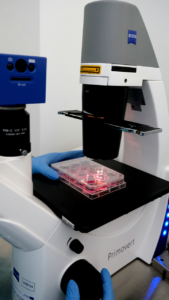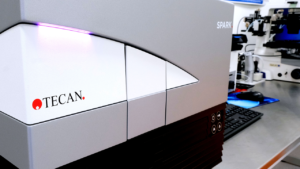Welcome to Kardio-Med Silesia Site
Silesian Park of Medical Technology Kardio-Med Silesia
is a modern research center meet the highest European standards.
 Cell research, also known as in vitro research, is scientific research conducted on living cells outside of a living organism. These studies are designed to understand the functions, reactions and interactions of cells, as well as to evaluate the effects of various substances or conditions on cells. In addition, they allow for the reduction of studies conducted on an in vivo animal model through the preliminary evaluation of a medical device or drug product’s potential cytotoxic effects on a cellular model.
Cell research, also known as in vitro research, is scientific research conducted on living cells outside of a living organism. These studies are designed to understand the functions, reactions and interactions of cells, as well as to evaluate the effects of various substances or conditions on cells. In addition, they allow for the reduction of studies conducted on an in vivo animal model through the preliminary evaluation of a medical device or drug product’s potential cytotoxic effects on a cellular model.
The Neutral Red Uptake (NRU) assay is an in vitro laboratory test used to assess cell viability and cytotoxicity. It relies on the use of Neutral Red dye, which is taken up by living cells and accumulates in lysosomes. The NRU assay is a cytotoxicity test classified as an in vitro quantitative assay. Tests using cell lines, such as biocompatibility assessment and Neutral Red uptake test, are conducted in our company at the Cell Laboratory in GLP standard.
Using the Neutral Red Uptake (NRU) test according to ISO 10993-5 – Biological Evaluation of Medical Devices – Part 5: Tests for in vitro cytotoxicity, mouse fibroblast cells (Balb3t3/L929 line) are exposed to various concentrations of extracts from test substances such as medical devices for a specified period of time at different concentrations. After exposure, the cells are incubated with a solution of neutral red dye. Viable cells actively accumulate neutral red in lysosomes. The dye becomes trapped in the lysosomes due to the acidic environment. The degree of dye uptake and retention can indicate cell health and viability. Absorption of dye by cells can be quantified by spectrophotometry, and the results can help assess the cytotoxicity or biocompatibility of the substances being tested.
 The in vitro NRU test is based on the principle of dye uptake and retention, causing a measurable color change, while damaged or dead cells will have reduced dye uptake. Dye uptake by cells can be quantified by spectrophotometry, and the results can help assess the cytotoxicity or biocompatibility of the test substances.
The in vitro NRU test is based on the principle of dye uptake and retention, causing a measurable color change, while damaged or dead cells will have reduced dye uptake. Dye uptake by cells can be quantified by spectrophotometry, and the results can help assess the cytotoxicity or biocompatibility of the test substances.
The in vitro neutral red uptake test is widely used in cell biology, toxicology, biocompatibility and development studies, medical devices, and drug products to assess the potential effects of various compounds on cell health and survival. It is worth noting that although the NRU assay provides valuable information on cytotoxicity, scientists often use it in combination with other in vitro tests to gain a more comprehensive understanding of the cellular response to various substances. The NRU test is one of several cytotoxicity tests defined by the guideline according to according to ISO 10993-5 – Biological Evaluation of Medical Devices – Part 5: Tests for in vitro cytotoxicity.
NRU cytotoxicity testing is extremely useful because of its precision, reproducibility and compliance with GLP regulations. It provides confidence that the biocompatibility assessment of a substance or medical device is performed according to the highest quality standards and can help ensure the safety of products used in contact with the human body.
We are certified by Good Laboratory Practice in the biocompatibility (scope 9) for biological evaluation of medical devices for in vitro cytotoxicity testing, among others.
Feel free to contact us to match the appropriate testing method to your medical device.







Copyright 2023 Kardio-Med Silesia. Site designed by Daniel 'zoNE' Gabryś. All rights reserved.